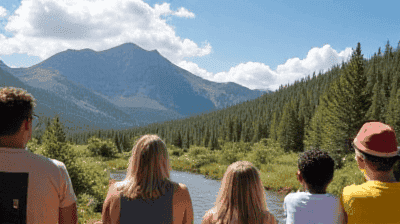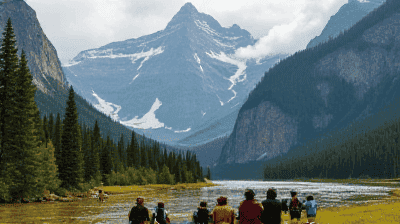
National parks are some of the most treasured landscapes in the world, offering breathtaking natural beauty, diverse ecosystems, and a haven for wildlife. They serve not only as places of recreation and inspiration for millions of visitors each year but also as critical environments for conserving biodiversity and cultural heritage. However, the increasing popularity of these natural areas has led to significant challenges, particularly overcrowding. As more people flock to national parks, the delicate balance between tourism and conservation becomes strained, resulting in environmental degradation, wildlife disturbances, and diminished visitor experiences.
Overcrowding in national parks refers to the excessive concentration of visitors in a specific area, often resulting in negative impacts on the environment, infrastructure, and the overall visitor experience. This phenomenon can manifest in various ways, including congested trails, full parking lots, littering, damaged vegetation, and increased human-wildlife interactions.
Several factors contribute to the increasing overcrowding of national parks:
Increased Accessibility: Improvements in transportation infrastructure, including roads and public transportation, have made national parks more accessible to a broader audience.
Social Media and Marketing: The rise of social media platforms has sparked a "travel influencer" culture, where visually appealing national parks are often shared widely, creating a desire among users to visit these destinations.
Growth in Domestic and International Tourism: The overall rise in global tourism has led to more people seeking outdoor experiences, resulting in increased visitation to scenic and recreational destinations.
Limited Visitor Education: Many parks lack sufficient educational resources on sustainable practices, leading visitors to engage in activities that may harm the environment.
Overcrowding can have several adverse effects, including:
Environmental Degradation: High visitor numbers can lead to soil erosion, habitat destruction, and the loss of native plant species. Excessive foot traffic on trails can result in widening paths and trampling of fragile ecosystems.
Wildlife Disturbances: Increased human presence can disrupt wildlife behavior, leading to stress, altered feeding patterns, and even abandonment of nests or dens.
Infrastructure Strain: Parking lots, restrooms, and visitor centers can become overwhelmed, compromising the safety and comfort of visitors and leading to overworked park staff.
Diminished Visitor Experience: Overcrowding can detract from the natural beauty and serenity that draws people to national parks in the first place. Congestion can result in long wait times and less opportunity for solitude and reflection.

To effectively address the issue of overcrowding in national parks, a multi-faceted approach is required. Here are several key solutions that can help balance tourism with conservation efforts:
Developing and implementing effective visitor management strategies is essential for mitigating overcrowding. Strategies may include:
Timed Entry Systems: Similar to those used by some popular parks like Yosemite, timed entry systems regulate the number of visitors allowed in the park during specific windows, thereby spreading out visitation and reducing congestion at peak times.
Reservation Systems: Parks can implement reservation systems that require visitors to book their access in advance. This approach can be particularly effective for high-demand sites and popular trails.
Visitor Flow Monitoring: Parks can utilize technology such as GPS tracking and visitor counters to monitor foot traffic patterns and adjust management strategies accordingly.
Improving infrastructure can help accommodate visitor needs while protecting park resources:
Expanded Parking Options: Developing additional parking areas and offering shuttles from nearby communities can alleviate congestion at popular trailheads and attractions.
Upgraded Visitor Facilities: Investing in modern restrooms, informational kiosks, and interpretative centers can enhance the visitor experience and promote responsible behaviors.
Development of Additional Trails: Creating new trails in under-visited areas can help disperse foot traffic, reducing impacts on popular sites.
Encouraging sustainable tourism practices among visitors can positively influence park conservation:
Educational Campaigns: Implementing educational programs that inform visitors about Leave No Trace principles, the importance of staying on marked trails, and proper waste disposal can promote environmentally responsible behaviors.
Wildlife Education: Creating awareness campaigns about local wildlife and the potential impacts of human interactions can help foster respect and minimize disturbances.
Storytelling and Interpretation: Using engaging storytelling and interpretative signage helps visitors understand the ecological significance of the park and the importance of conservation.
Adjusting operational practices according to seasonal patterns can help manage overcrowding:
Off-Peak Promotion: Parks can incentivize visitation during off-peak times through discounts, special events, or educational programs that highlight seasonal attractions.
Seasonal Closures: Certain areas may benefit from temporary closures during peak breeding or nesting seasons for sensitive wildlife. This approach can give ecosystems a much-needed respite.
Building partnerships between national parks and surrounding communities can benefit both tourism and conservation efforts:
Community Engagement: Involving local residents in park management and planning processes can foster a sense of ownership and responsibility over nearby natural resources.
Sustainable Tourism Development: Working with local businesses to develop sustainable tourism initiatives can enhance visitor experiences while supporting economic growth in the region.
Implementing and enforcing regulations that promote environmental protection and visitor safety is paramount:
Zoning Regulations: Establishing designated recreation zones can help minimize impacts on sensitive areas while directing visitor activities to more sustainable habitats.
Enhanced Enforcement: Increasing the presence of park rangers and visitors services can deter harmful behaviors and ensure compliance with park rules.
Emerging technologies can assist in visitor management and conservation:
Mobile Applications: Apps that provide real-time updates on trail conditions, crowded areas, or alternative sites can encourage visitors to explore less crowded destinations.
Virtual Reality Experiences: Offering virtual experiences that highlight national park ecosystems can engage potential visitors and reduce the strain on physical locations.
Investing in research to understand visitor behaviors and the impacts of tourism can lead to more informed management practices:
Longitudinal Studies: Conducting studies on the lasting effects of high visitation on ecosystems can help inform management decisions.
Visitor Surveys: Regularly collecting feedback from visitors can provide insight into their experiences and preferences, guiding future planning efforts.
While park management plays a crucial role, visitors can also contribute to alleviating overcrowding and protecting natural resources. Here are some ways individuals can make a difference:
Travelers should be strategic about when and where they visit national parks. Researching peak times, weather conditions, and special events can enhance the experience and reduce congestion.
Choosing lesser-known national parks or alternative outdoor destinations not only helps alleviate overcrowding but also provides opportunities to discover hidden gems while supporting local economies.
Visitors can contribute directly to conservation initiatives by volunteering for restoration projects, joining citizen science programs, or donating to organizations dedicated to protecting natural habitats.
Applying responsible outdoor etiquette, such as sticking to marked trails, packing out trash, and respecting wildlife can help preserve the integrity of national parks.
Being an advocate for national parks and sustainable tourism can lead to more awareness and action. This can include sharing experiences on social media, engaging in community discussions, and supporting policies that promote conservation.

National park overcrowding presents significant challenges that threaten the very essence of these cherished landscapes. However, a balanced approach that combines effective management strategies, community engagement, and responsible visitor practices can help protect these natural treasures for future generations. By fostering a culture of awareness and appreciation for the delicate ecosystems within our national parks, we can promote both tourism and conservation, ensuring that these iconic spaces continue to inspire and educate all who visit.